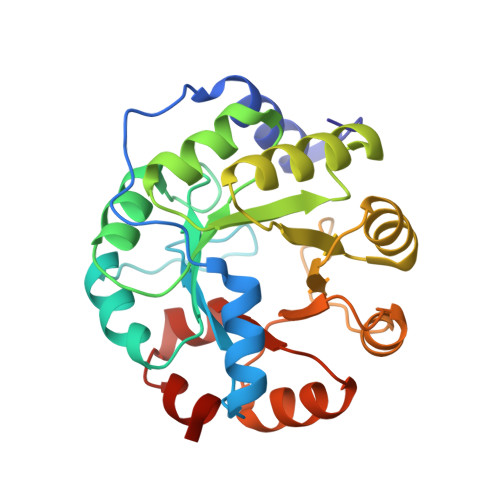Bridging the gaps in design methodologies by evolutionary optimization of the stability and proficiency of designed Kemp eliminase KE59.
Khersonsky, O., Kiss, G., Rothlisberger, D., Dym, O., Albeck, S., Houk, K.N., Baker, D., Tawfik, D.S.(2012) Proc Natl Acad Sci U S A 109: 10358-10363
- PubMed: 22685214
- DOI: https://doi.org/10.1073/pnas.1121063109
- Primary Citation of Related Structures:
3UXA, 3UXD, 3UY7, 3UY8, 3UYC, 3UZ5, 3UZJ - PubMed Abstract:
Computational design is a test of our understanding of enzyme catalysis and a means of engineering novel, tailor-made enzymes. While the de novo computational design of catalytically efficient enzymes remains a challenge, designed enzymes may comprise unique starting points for further optimization by directed evolution. Directed evolution of two computationally designed Kemp eliminases, KE07 and KE70, led to low to moderately efficient enzymes (k(cat)/K(m) values of ≤ 5 10(4) M(-1)s(-1)). Here we describe the optimization of a third design, KE59. Although KE59 was the most catalytically efficient Kemp eliminase from this design series (by k(cat)/K(m), and by catalyzing the elimination of nonactivated benzisoxazoles), its impaired stability prevented its evolutionary optimization. To boost KE59's evolvability, stabilizing consensus mutations were included in the libraries throughout the directed evolution process. The libraries were also screened with less activated substrates. Sixteen rounds of mutation and selection led to > 2,000-fold increase in catalytic efficiency, mainly via higher k(cat) values. The best KE59 variants exhibited k(cat)/K(m) values up to 0.6 10(6) M(-1)s(-1), and k(cat)/k(uncat) values of ≤ 10(7) almost regardless of substrate reactivity. Biochemical, structural, and molecular dynamics (MD) simulation studies provided insights regarding the optimization of KE59. Overall, the directed evolution of three different designed Kemp eliminases, KE07, KE70, and KE59, demonstrates that computational designs are highly evolvable and can be optimized to high catalytic efficiencies.
Organizational Affiliation:
Department of Biological Chemistry, Weizmann Institute of Science, Rehovot 76100, Israel.
















